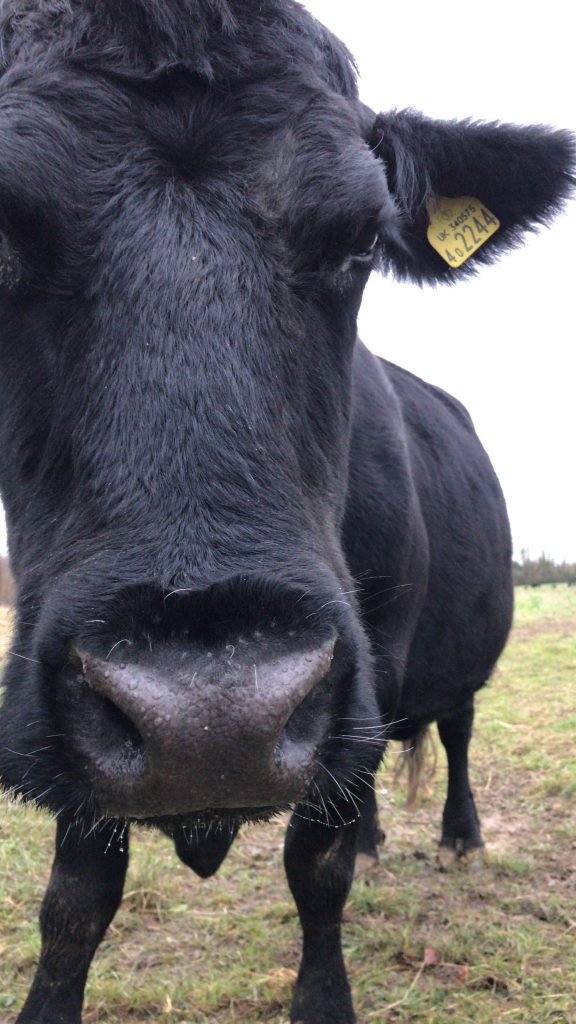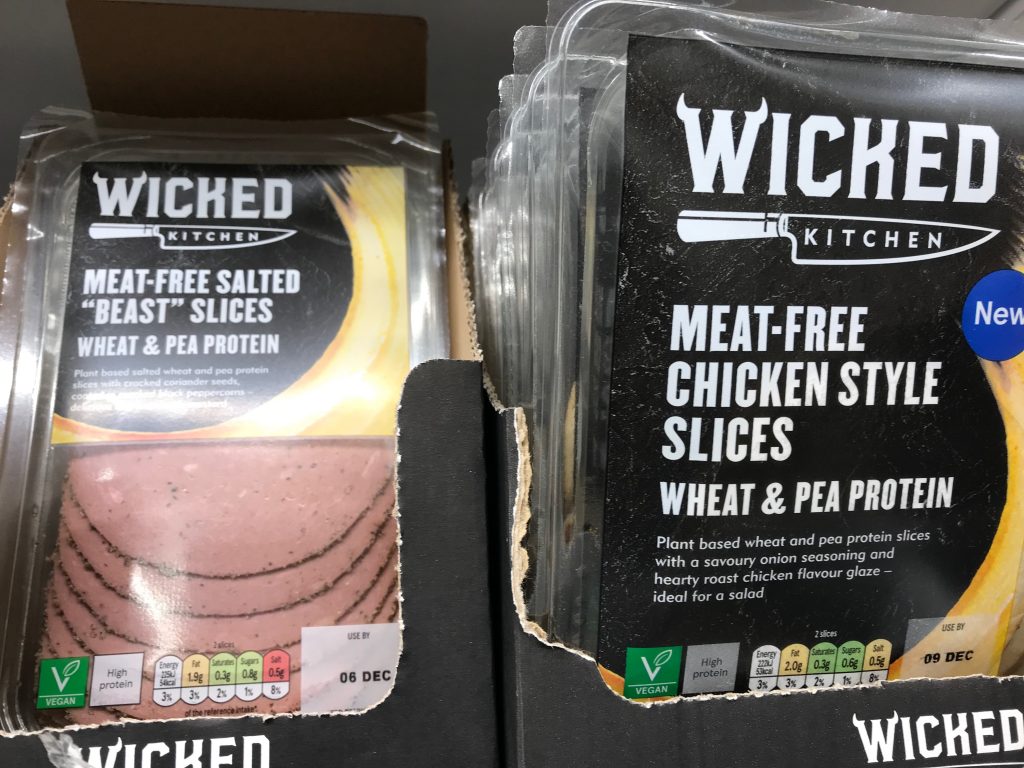View from the Hill 20th December 2021

Our suckler cows have been doing a walk-through of some of our cover crops, a few days in each field, having a nibble as they go, but leaving some greenery to keep the soil covered and some root activity underground. I had a chat with old 2244 one day, (our second oldest cow, at 13) she was hanging around by the gate, and happy for me to scratch behind her ears. She seemed to be enjoying the diet, although she did tell me that they didn’t much fancy the beans in the mixture, which I had already surmised, as beans still stand all across the field, where much else has been consumed. She couldn’t explain what it was about beans, they just don’t like them.

Around many of our arable fields, the fencing is not particularly cow proof, so we have to augment some stretches with a strand of electric. Which brings to mind the latest thing in cow grazing management, it is called No-fence. It is a whizzy bit of technology requiring every cow to wear a collar, which is solar powered and GPS linked, and uses a digital boundary. The collar is controlled by a phone app.
Simply define an area on your phone screen, and build a virtual fence. The fence can easily be adjusted or moved, giving the animals access to fresh pastures whenever you decide. If an animal wanders close to the boundary, it will hear a warning sound from the collar. No-fence trains the animals to back off when they hear the sound. If they ignore the sound, a weak but effective electric pulse can be given as a last resort. Personally I can’t quite see how this would work with frisky calves who hit the line at a gallop. I hear that the Knepp estate in Sussex (famous for its rewilding project) uses these collars to effectively mob graze their pastures. A niggling question arises: if electric dog collars are to be banned, as they are already in Wales, will this technique survive ? One can make quite a good argument that the occasional discomfort for the wayward animal is worth it in terms of the value to soil and water health of optimum grazing management. If it rains a lot, the soil can be poached by animals’ feet so they will need to be moved on more quickly than if frosty or dry. There is a potential saving in labour here too, we spend a lot of time erecting and removing electric fence, and arranging water troughs so the animals have access to water. Careful drawing of virtual boundaries could make this all much simpler.

The cows were recently examined by the long arm of the vet, who discovered that all but 3 are in calf, not a bad result. This year’s calves have now been weaned and the cows are indoors, munching on stemmy silage we made from our new strips of insect habitat. Their wayward offspring escaped from their field on their first night alone and returned to Websley in search of their mothers, prompting an escape from the yard, a break-in to a garden, the breaking of two gates and generally causing mayhem. The calves themselves then had to be confined to the yard until they calmed down and had forgotten about mummy. As I write this update prior to publishing on 27th December, they are happily tucking into a cover crop mixture of at least 10 plant species, including phacelia, linseed, gold of pleasure, peas, beans, daikon radish, fodder radish, turnips, and two vetches, though still they ignore the beans.


Our agronomist Greg found these little devils on 10th November. They are aphids, which can often be easily found on crops in the autumn, though once we’ve had a few frosts their numbers diminish. They are important to cereal growers because sometimes they carry a disease called barley yellow dwarf virus, which can cause stunting and serious yield reduction in cereal crops, it affects barley worst. Traditionally we have controlled them with insecticide, but this will eventually lead to resistance in the aphids, and will kill potential predators, so we have given up that route and now grow more insect habitat hoping we can encourage the predators. We sow our autumn crops a little later than we used to, to reduce pressure from the aphids as the weather cools. The biology of aphids bears a little scrutiny, here is an interesting account from a scientist, which I found a while ago, sadly I lost track of their name:
During favourable conditions, when food is plentiful, aphids undergo asexual reproduction. Not requiring ‘two to tango’, means a solitary aphid can produce a large, sap-sucking colony within days. At university we investigated aphids under binocular microscopes, and were told to squeeze them and observe as many as a dozen unborn aphids shoot out from a single specimen. Then, with the microscope’s magnification ramped up, asked to do the same to the unborn aphids. Incredibly the same thing occurs, unborn aphids that are themselves pregnant! It was like opening a Russian doll for the first time. Undertaking this squeamish act allowed me to appreciate how they can multiply incredibly quickly.
Not only this, but when food is plentiful, the young aphids will be born wingless, and will only spread relatively slowly from their place of birth, forming noticeable foci of infection. However, if food gets short, the aphids can start to produce winged babies again, which can depart to pastures new.

There has been a lot of talk over the last year about Net Zero, carbon sequestration, carbon footprints, carbon trading, carbon offsets, soil carbon, accompanied by questions like ‘how much carbon are our animals emitting’, and ‘what is the carbon equivalent of a ton of fertiliser?’ We have become obsessed with carbon. A new company pops up every month to tell us they have a fancy new algorithm which will tell us how much carbon can be sequestered by our farm, and how much they will earn for us if we would only let them trade it for us.
A curse on all their houses. Who in their right mind thinks that after nearly 100 years of soil wrecking cultivations and fertiliser use, we can turn it around overnight and start selling carbon credits to companies wanting to salve their carbon polluting consciences, rather than actually control their own emissions ? We need to find our own net zero first, and that’s not going to be easy, especially as long as we continue using artificial nitrogen in such quantities.
Offsetting will not make the slightest difference to overall emissions, and this is where our challenge lies. Emissions must fall, everywhere, and as quickly as possible, there is so much evidence of the damage being done worldwide by global warming. And for those who choose not to believe it, in the face of oceans of scientific evidence, is it something we should even risk getting wrong anyway ?
So back to farm level. There is a lot we can do to start to improve things, there is so much information out there, but a little pointless to repeat it here. The government already runs schemes like Countryside Stewardship (CSS) with rewards for soil/carbon friendly farming. The Sustainable Farming Initiative (SFI) looks like it is trying to do the same, the rewards don’t look great right now, but the standards should be quite easy for many farmers to achieve, and that is what DEFRA wants, widespread engagement. Considering how much other rubbish HM govt is emitting at the moment, this actually makes a bit of sense. Once the new Environmental Land Management schemes (ELMS) are fully available one might hope that there will be serious rewards available for doing the right thing.
Farmers are vulnerable to being duped in the emerging, voluntary carbon market referred to above, unless a proper farmland carbon code comes along pretty quickly. We all know how variable soil carbon testing is, so how on earth is any of this going to be measured? To my mind it looks a safer bet to take DEFRA’s money for now, while it is still offered, why not use it to finance some trials of our own to try something different, so that perhaps when those offers dry up, we will be in a better place to take on the carbon market, which by then may have matured a little, with some commonly agreed standards.


With the annual veganuary charade around the corner, should we be marketing meat as ‘vegan-free’, we could be missing a trick ?
What I struggle to understand is why, if you are marketing a product like this to a vegan-minded customer, you would bother with the pretence that it is like meat when it is clearly not. And if you are a consumer wanting to buy something that is like meat, then just buy meat !
All things in moderation, as Mother used to say. A heathy mixed diet is what we need, and clearly we need to rein back on consumption of everything, from cars, and international holidays, to meat feast pizzas and plastic rubbish that serves no useful purpose (eg the contents of christmas crackers!) With that cheerful thought, I will leave it to see what comments arise…………

Fantastic. Those cow collars do seem to work because I have seen them being used for several years now on common land where Highland and Dexters are used to keep overgrowth down. I can’t see the problem with a licensed dog collar system – very handy if you could set the distance a dog could roam from one’s phone.
I remember all that stuff on aphids from university ( might you have been asleep G?) and it is not so different in our animal – female babies are born with oocytes immature eggs; a limited number determined at birth I believe.
No crackers in our house: Recycling should I agree come after Reduce and Reuse and buying up bits of Wales in the name of carbon offsetting should be nowhere at all. Happy New Year.
I think that it is such a good idea that Richard Branson has banned beef from the menus of his transatlantic flights because of the carbon footprint.
Great stuff as usual. Knepp use the collars so they can find the cattle in the wood….Branson should know that a greater evil cannot be eclipsed by a lesser evil, or perhaps he should source his beef from a grass/organic system and contribute to sequestration that way…
Dear George,
Who,outside from those who focus on aphids,would know what incredible succession abilities they have? I can not do more than to wish you success in your new year as you continue to search for optimum solutions for the land and plants and animals in your care . Not forgetting the conundrum of the beans!!
Rogxxxxx
Happy New year George, what an interesting column this month, aphids really are clever little B,s good luck with your predator experiments!! They’ll need to be hungry!. I could use one of those collars do you think it would work on a Spaniel? Perhaps not.
All the best for 2022 Andrew
You don’t say whether your laissez faiire approach ,adopting a non spray programme has worked with the aphids. There are ,as I’m sure you are aware, some predator friendly sprays on the market.?perhaps they drowned in the recent rain?!
Best yet George. Can I share to Quoram Sense NZ?
Insightful and fascinating as usual George. Thank you and a very happy New Year.